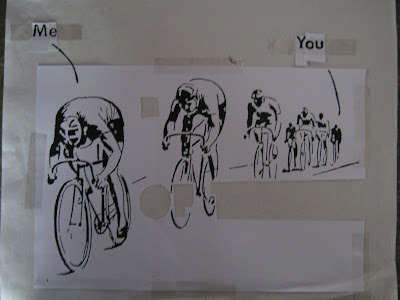Start
I am Swiz, aka Michael G Swifte. I like making lamps from found objects. I also like riding bikes and after joining the single speed craze I decided that I could apply my lamp approach to bike saddles.
Learning to repair and reupholster has been challenging. I've found no experts or fonts of knowledge in the bike saddle area. Materials are hard to acquire and the work is painstaking and hard on the hands.
I've tracked down a few key materials for reconditioning old and damaged saddles: short leg staples (6mm), extreme temperature resistant tape, and flexible fabric adhesive. I have a collection of tennis racket covers which are the ideal size for saddle covers. They have a fabric backing, sporty printed designs, and are fairly thin and flexible. I hope to move to a different staple gun with an even shorter leg staple (4mm). I've also acquired a hair dryer to soften vinyl while stretching. I haven't tried yet but hope it will allow me to get a better finish around the edges on the nose and rear corners which require a series of small pleats.
From my experiments stretching vinyl I've formed the opinion that heat shrinking methods are used to upholster most saddles.
My aim is to produce saddles that are sturdy, sporty, attractive, colourful, and upcycled. There appears to be very little difference between the saddle shell in a high-end saddle over a cheap saddle. A good saddle is defined by the padding design and the quality of upholstery. In my opinion appropriate thickness and placement are more important than the type of padding. For me it is most important to be mindful of the causes of perinial stress from padding placement.
Overall saddle shape is vitally important, I take the Selle Italia Turbo and the Selle San Marco Laser as the ideal. They are attractive and comfortable. They look good on a wide range of frames, come in a range of colours, and are relatively free of decals and patterns.
Bellow are photos of a cheap chinese saddle at various stages of reconditioning. Note that the padding in the original saddle was not attached to the shell.
 Finished experimental saddle with heavy blue vinyl. Unattractive pinching at the nose and back corners.
Finished experimental saddle with heavy blue vinyl. Unattractive pinching at the nose and back corners.
 Cheese cloth layer stretched and glued.
Cheese cloth layer stretched and glued.
 Padding fixed with extreme temperature resistant and uneven surface conforming tape.
Padding fixed with extreme temperature resistant and uneven surface conforming tape.
Learning to repair and reupholster has been challenging. I've found no experts or fonts of knowledge in the bike saddle area. Materials are hard to acquire and the work is painstaking and hard on the hands.
I've tracked down a few key materials for reconditioning old and damaged saddles: short leg staples (6mm), extreme temperature resistant tape, and flexible fabric adhesive. I have a collection of tennis racket covers which are the ideal size for saddle covers. They have a fabric backing, sporty printed designs, and are fairly thin and flexible. I hope to move to a different staple gun with an even shorter leg staple (4mm). I've also acquired a hair dryer to soften vinyl while stretching. I haven't tried yet but hope it will allow me to get a better finish around the edges on the nose and rear corners which require a series of small pleats.
From my experiments stretching vinyl I've formed the opinion that heat shrinking methods are used to upholster most saddles.
My aim is to produce saddles that are sturdy, sporty, attractive, colourful, and upcycled. There appears to be very little difference between the saddle shell in a high-end saddle over a cheap saddle. A good saddle is defined by the padding design and the quality of upholstery. In my opinion appropriate thickness and placement are more important than the type of padding. For me it is most important to be mindful of the causes of perinial stress from padding placement.
Overall saddle shape is vitally important, I take the Selle Italia Turbo and the Selle San Marco Laser as the ideal. They are attractive and comfortable. They look good on a wide range of frames, come in a range of colours, and are relatively free of decals and patterns.
Bellow are photos of a cheap chinese saddle at various stages of reconditioning. Note that the padding in the original saddle was not attached to the shell.
 Finished experimental saddle with heavy blue vinyl. Unattractive pinching at the nose and back corners.
Finished experimental saddle with heavy blue vinyl. Unattractive pinching at the nose and back corners. Cheese cloth layer stretched and glued.
Cheese cloth layer stretched and glued. Padding fixed with extreme temperature resistant and uneven surface conforming tape.
Padding fixed with extreme temperature resistant and uneven surface conforming tape.



Comments
Post a Comment